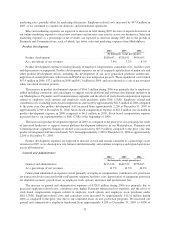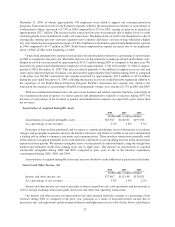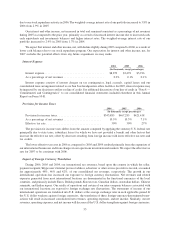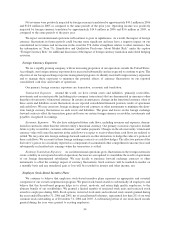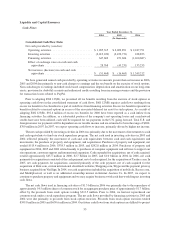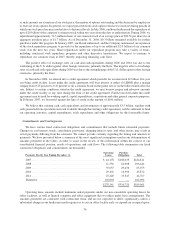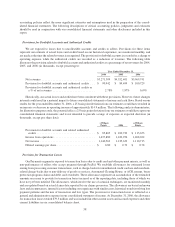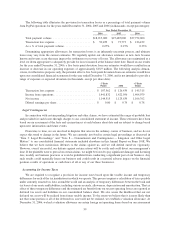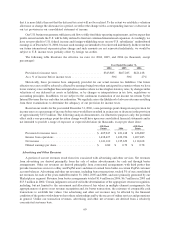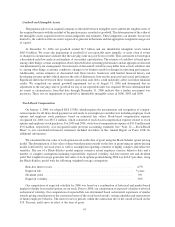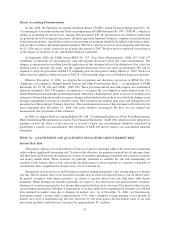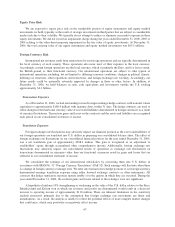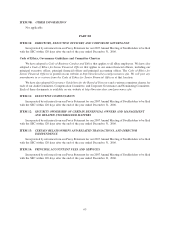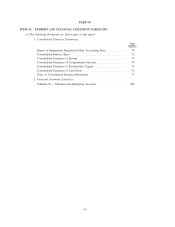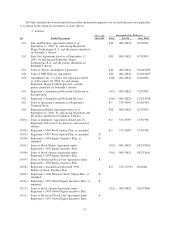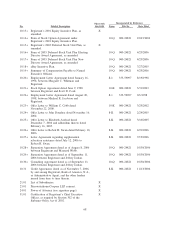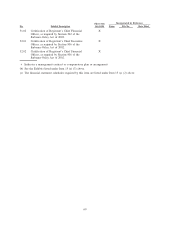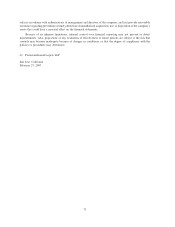eBay 2006 Annual Report Download - page 65
Download and view the complete annual report
Please find page 65 of the 2006 eBay annual report below. You can navigate through the pages in the report by either clicking on the pages listed below, or by using the keyword search tool below to find specific information within the annual report.Goodwill and Intangible Assets
The purchase price of an acquired company is allocated between intangible assets and the net tangible assets of
the acquired business with the residual of the purchase price recorded as goodwill. The determination of the value of
the intangible assets acquired involves certain judgments and estimates. These judgments can include, but are not
limited to, the cash flows that an asset is expected to generate in the future and the appropriate weighted average cost
of capital.
At December 31, 2006 our goodwill totaled $6.5 billion and our identifiable intangible assets totaled
$683.0 million. We assess the impairment of goodwill of our reportable units annually, or more often if events
or changes in circumstances indicate that the carrying value may not be recoverable. This assessment is based upon
a discounted cash flow analysis and analysis of our market capitalization. The estimate of cash flow is based upon,
among other things, certain assumptions about expected future operating performance and an appropriate discount
rate determined by our management. Our estimates of discounted cash flows may differ from actual cash flows due
to, among other things, economic conditions, changes to its business model or changes in operating performance.
Additionally, certain estimates of discounted cash flows involve businesses with limited financial history and
developing revenue models which increase the risk of differences between the projected and actual performance.
Significant differences between these estimates and actual cash flows could materially affect our future financial
results. We completed our annual goodwill impairment test as of August 31, 2006 and determined that no
adjustment to the carrying value of goodwill for any of our reportable units was required. We have determined that
no events or circumstances from that date through December 31, 2006 indicate that a further assessment was
necessary. There was no impairment of goodwill or identifiable intangible assets in 2006, 2005 and 2004.
Stock-Based Compensation
On January 1, 2006, we adopted FAS 123(R), which requires the measurement and recognition of compen-
sation expense for all share-based payment awards made to our employees and directors including employee stock
options and employee stock purchases based on estimated fair values. Stock-based compensation expense
recognized for 2006 was $317.4 million, which consisted of stock-based compensation expense related to stock
options and employee stock purchases. For 2005 and 2004, stock-based compensation expense of $31.8 million and
$5.8 million, respectively, was recognized under previous accounting standards. See “Note 12 — Stock-Based
Plans” to our consolidated financial statements included elsewhere in this Annual Report on Form 10-K for
additional information.
We calculated the fair value of each option award on the date of grant using the Black-Scholes option pricing
model. The determination of fair value of share-based payment awards on the date of grant using an option-pricing
model is affected by our stock price as well as assumptions regarding a number of highly complex and subjective
variables. The use of a Black-Scholes model requires extensive actual employee exercise behavior data and a
number of complex assumptions including expected life, expected volatility, risk-free interest rate and dividend
yield. The weighted-average grant-date fair value of stock options granted during 2006 was $10.47 per share, using
the Black-Scholes model with the following weighted-average assumptions:
Risk-free interest rates .................................................... 4.7%
Expected life ........................................................... 3years
Dividend yield ......................................................... 0%
Expected volatility....................................................... 36%
Our computation of expected volatility for 2006 was based on a combination of historical and market-based
implied volatility from traded options on our stock. Prior to 2006, our computation of expected volatility was based
on historical volatility. Our computation of expected life was determined based on historical experience of similar
awards, giving consideration to the contractual terms of the stock-based awards, vesting schedules and expectations
of future employee behavior. The interest rate for periods within the contractual life of the award is based on the
U.S. Treasury yield curve in effect at the time of grant.
61


